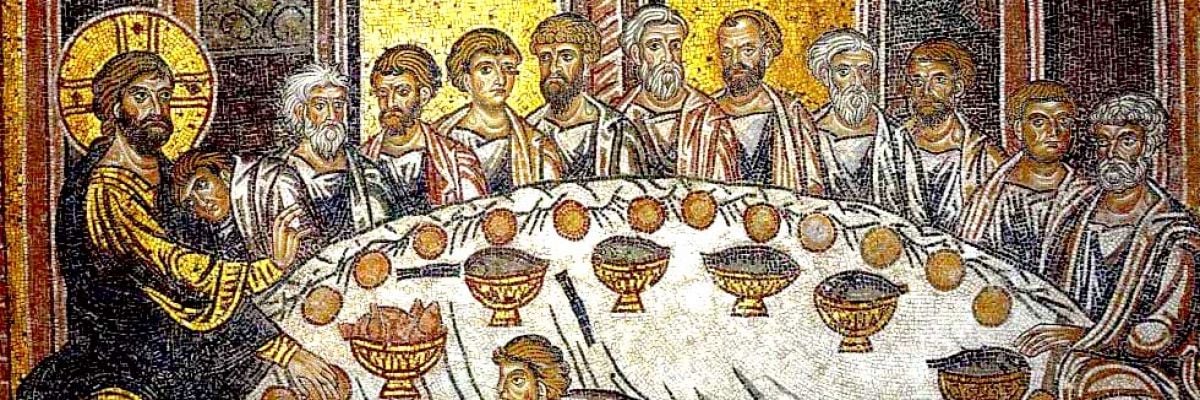
It is an infallible teaching of the Catholic Church that the Eucharist is a sacrifice—in particular, the one sacrifice of Christ. The Council of Trent declared:
If any one saith, that, by the sacrifice of the mass, a blasphemy is cast upon the most holy sacrifice of Christ consummated on the cross; or, that it is thereby derogated from; let him be anathema (The Canons on the Sacrifice of the Mass, canon 4).
The Catechism of the Catholic Church reaffirms Trent’s teaching: “The Eucharist is . . . a sacrifice” (CCC 1365).
The Catholic understanding of the Eucharist rests on the belief that the Last Supper was a sacrifice. Blessed Pope Paul VI, in his 1965 encyclical Mysterium Fidei, called the Last Supper the “Eucharistic sacrifice” (MF 4).
But Protestants reject this. They don’t believe the Last Supper was a sacrifice, and consequently they don’t believe the Christian celebration of the Eucharist is a sacrifice—it’s merely a memorial, they say.
Was the Last Supper a sacrifice or not? I will give five clues that suggest Jesus intended the Last Supper to be a sacrifice—and in particular his sacrifice.
Clue #1: “Blood poured out”
The first clue that screams sacrifice is Jesus’ language of his blood being poured out. The pouring of blood is reminiscent of the Old Testament atoning sacrifices. For example, Leviticus 4:7 describes how the priest was to pour the blood of the victim at the base of the altar on which the victim was offered. When Jesus speaks of pouring out his blood, we can reasonably conclude he understood the Eucharist to be an atoning sacrifice—especially when we consider how Jesus speaks of his blood being poured out for the forgiveness of sins (see Matthew 26:28).
Clue #2: “Do this”
The sacrificial nature of the Last Supper is further revealed by Jesus’ command to “do this” (Luke 22:19). The Greek reads poieite touto. In the Greek version of the Old Testament (the Septuagint), the word poieo, which is the root for poieite, is translated as “offer” with regard to offering sacrifices:
- “Now this is what you shall offer [Greek, poieseis] upon the altar: two lambs a year old day by day continually” (Exod. 29:38).
- “Draw near to the altar, and offer [Greek, poieson] your sin offering and your burnt offering, and make atonement for yourself and for the people” (Lev. 9:7).
- “I will offer [Greek, poies?] to thee burnt offerings of fatlings, with the smoke of the sacrifice of rams” (Psalm 66:15).
If Jesus is commanding the apostles to poiete (offer) the Eucharist, then he intends for it to be a sacrifice.
Clue #3: “In remembrance of me”
Not only did Jesus tell the apostles to “do this,” he said, “do this in remembrance of me” (Luke 22:19; emphasis added). The Greek word for remembrance is anamnesis, which has sacrificial overtones in both the New and Old Testaments. For example, in the Septuagint, Moses tells the Israelites that their burnt offerings and peace offerings would serve as an anamn?sis (“remembrance”) before God (see Numbers 10:10). The author of Hebrews sees the Old Testament sacrifices in the same light: “But in these sacrifices there is a reminder [Greek, anamn?sis] of sin year after year” (Heb. 10:3). When we consider these sacrificial overtones of anamnesis, combined with the sacrificial meaning of poiete, we have good reason to believe Luke’s use of anamn?sis suggests the Last Supper is a sacrifice.
Clue #4: “Given for you”
A fourth clue regarding the sacrificial nature of the Last Supper is Luke’s use of the Greek word didomi, which is used for “given” in Jesus’ statement “This is my body given for you” (Luke 22:19; emphasis added).
Elsewhere in the New Testament didomi is used with reference to sacrifices. For example, Luke writes, “[T]hey [Mary and Joseph] brought him [Jesus] up to Jerusalem to present him to the Lord . . . and to offer [Greek, didomai] a sacrifice according to what is said in the law of the Lord” (Luke 2:24).
Mark uses didomi when he speaks of Jesus’ atoning death on the cross:“For the Son of man also came not to be served but to serve, and to give [Greek, didomai]his life as a ransom for many” (Mark 10:45). Knowing that didomi is a word used for sacrifice, we can add it to our evidence that suggests the sacrificial nature of the Last Supper.
Clue #5: “Blood of the covenant’”
The “blood of the covenant” found in Matthew’s Last Supper narrative is another sacrificial phrase. Moses used the same language with reference to the sacrificial victim during the ratification ceremony of the Sinaitic covenant: “Behold the blood of the covenant which the LORD has made with you in accordance with all these words” (Exod. 24:8).
By using the phrase “blood of the covenant,” Jesus is drawing a parallel between the Sinaitic covenant and the Last Supper. If the ratifying ceremony for the Sinaitic covenant was a sacrifice, then the Last Supper, which is the ratifying ceremony for the New Covenant, must also be a sacrifice.
Pray tell what sacrifice?
Although there are more clues that suggest the sacrificial nature of the Last Supper, I think these suffice. But now we must ask, “What sacrifice is the Last Supper?” The answer is, “It’s Christ’s sacrifice!” The Catechism of the Catholic Church states:
In the Eucharist Christ gives us the very body which he gave up for us on the cross, the very blood which he “poured out for many for the forgiveness of sins.” The Eucharist is thus a sacrifice because it re-presents (makes present) the sacrifice of the cross (CCC, 1365-1366).
What’s the biblical support? Notice in the Last Supper narratives Jesus speaks of his own body being given up (see Luke 22:19) and his own blood being poured out (see Mark 14:24, Matthew 26:28, Luke 22:20). What’s interesting is that he doesn’t speak of his body and blood as that which will be given up and poured out. In all of the institution narratives Jesus speaks of giving his body and blood in the present tense—“this is my body which is given for you” (Luke 22:19); “the cup which is poured out for you” (Luke 22:20; Mark 14:24; Matt. 26:28). This suggests that the bloody sacrifice Jesus was to offer on the cross the next day was mysteriously made present in an unbloody manner.
Conclusion
It’s interesting that Protestants often tout themselves as being more biblically oriented than Catholics. Yet when it comes to the sacrificial nature of the Last Supper, I think it’s the Catholic who can say his belief is more biblical than the Protestant’s.



